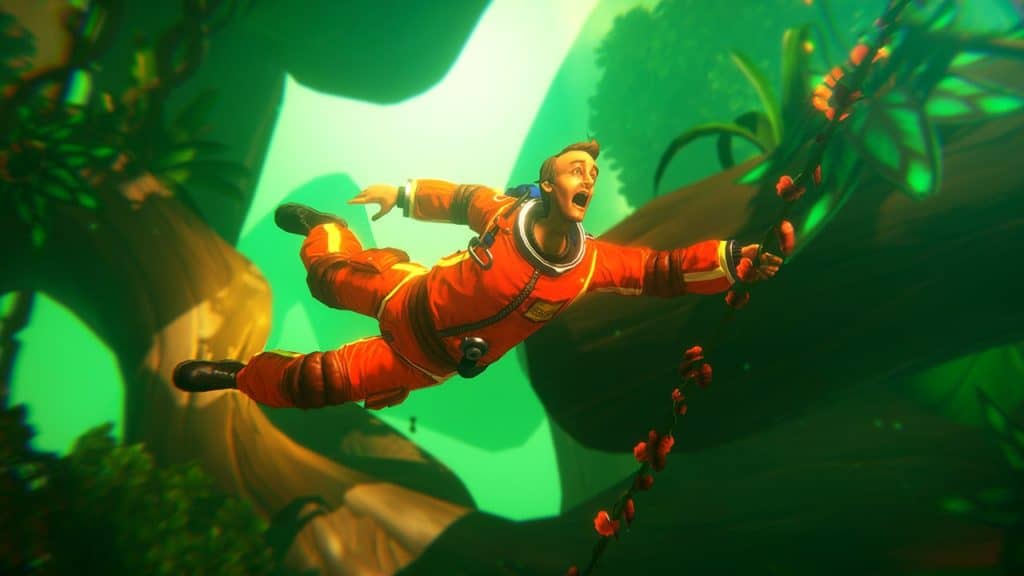Video Gamer is reader-supported. When you buy through links on our site, we may earn an affiliate commission. Prices subject to change. Learn more
Little Orpheus, available on Apple Arcade, is the latest release from The Chinese Room, a British studio whose games—often dubbed “walking simulators”—are both loved and loathed. If you found the likes of Dear Esther and Everybody’s Gone to the Rapture boring and crusty, you may be disheartened to hear that “boring” and “crusty” describe the new game nicely. But not in the way that you think. The boring is done by an enormous nuclear-bomb-powered drilling machine, the Little Orpheus, and the crust is the Earth’s; which gives way, revealing a land that time—if not Hollywood or the pages of pulp science-fiction—forgot.
You know the drill: dinosaurs, damp thickets of jungle, the looming ruins of lost civilisations. However, there’s a twist. The year is 1965; you are a Russian cosmonaut, Ivan Ivanovich Privalov; and, while the Moon beckons America, the burrowing is done in the name of the Motherland. Emerging after a three-year disappearance, Privalov is debriefed by General Yurkovoi—a slab of Soviet meat, squeezed into a military uniform. Yurkovoi, hunting the Orpheus and, more important, its fuel source, is convinced that Privalov’s account is a collection of tall tales, and the debriefing—furnished with looping tape reels and cast in foggy black-and-white—has the tone of an interrogation: “You will tell me where my bomb is, or I will have you shot.” The tales, fanciful or otherwise, are offered up as segments of simple platforming, overlaid with anxious narration, and sneers of scepticism from the general.

When starting Little Orpheus, I have to confess to feeling similarly sceptical—not of our hero’s rousing escapades but for the way in which they are wrangled; even the best platformers, no matter how smooth, are smudged by touchscreen controls. The Chinese Room, abiding with its own traditions, keeps the mechanics to a sensible minimum. There are levers and buttons, blocks to stand on, gulping chasms to leap, and creatures to outsprint—all on a two-dimensional plain. Run, jump, push, and pull: the sparse tools at your disposal are activated by tapping and sliding a pudgy thumb across the screen of your phone or tablet. (I recommend the latter, for reasons of real estate; an iPad widens your gaze, banishing your hands farther to the fringes.) The shortfalls of such methods are felt most keenly when falling short—not registering a jump, for instance, despite the fleshy jab of a plea, and plunging Privalov to his untimely death.
These fumbles are relatively minor—minor fumbling being the best-case scenario for a phone-based platformer—and, when play rattles along without a hitch, you notice it retreat to the background. This is where Little Orpheus clicks into place with the developer’s previous games, wherein mechanics are the thing least worth talking about. Consider Dear Esther, set on a grief-haunted isle in the Hebrides, in which a straight story was swapped for drama that dripped from the environment, however it was happened upon. All you did was walk, look, and listen; as far as The Chinese Room is concerned, being is mechanic enough. So it is that the best moments in Little Orpheus, in lockstep with a linear story, are synchronised with the act of moving. One scene has Privalov pursued by a giant worm, its lunging bites timed with Yurkovoi’s barking inquiries. Another sees you sneak by a T. Rex, disguised as an egg, each step punctuated with a plucked string.

Where Little Orpheus differs from its predecessors, and what marks it as a curious mobile game, is that you appreciate it most when you aren’t playing. If you can fit a chapter into the frazzle of a commute, say, lightly carbonating your day with the tonic of adventure, so much the better. Taken in a concentrated sitting, though, you may find it goes flat. The opposite is true of Everybody’s Gone to the Rapture; set in an English village at the end of the world, it holds you rapt amidst the hedges and the chanting choirs, imparts something profound, and then melts away like morning dew. Why should this be so? What is it about Little Orpheus that makes a deeper impression when it’s out of your hands?
In a word: ideas. Not since Metal Gear Solid 3: Snake Eater have I played a game that suggested visually that the Cold War was, in fact, anything but. The art style, led by John McCormack, captures the heat—not only of the jungles and deserts but of the sort that simmers between nations—in flaring technicolour. And yet, serious is off the menu. The entire thing is presented as something that children would tune into. The cutscenes are filtered through a layer of fuzz, with bars of static at the top and bottom, and each episode is bracketed with a brassy theme, by Jim Fowler and Jessica Curry, which you can imagine bounding forth from a Nick Park project. For me, the game’s masterstroke is that it installs a thematic core within a hollow premise. The mission, as Yurkovoi outlines it, is “to drill to the centre of the Earth, and find out if we could establish a city there.” What could be a more perfect symbol for the Soviet Union during the Cold War? A country tunneling into itself and praying for a promised land. Workers of the world, unite! Everybody’s gone to the rupture!
Developer: The Chinese Room
Publisher: Sumo Digital
Available on: Apple Arcade
Release date: June 12, 2020
To check what a review score means from us, click here.

